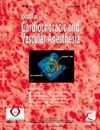早期俯卧位作为双侧肺移植术后中重度原发性移植物功能障碍的挽救疗法
IF 2.3
4区 医学
Q2 ANESTHESIOLOGY
Journal of cardiothoracic and vascular anesthesia
Pub Date : 2025-02-01
DOI:10.1053/j.jvca.2024.11.018
引用次数: 0
摘要
目的:原发性移植物功能障碍(PGD)影响肺移植(LT)后的生存。目前的假设是,俯卧位(PP)作为治疗PGD引起的难治性低氧血症的抢救手法,可以改善LT的预后,特别是在早期应用时。设计:双侧肝移植受者在重症监护室入院后24小时内出现中度至重度PGD。从2020年1月至2021年11月,LT后发生PGD的患者在诊断后24至48小时内转为俯卧,仅在放射学或氧合恶化的情况下(“晚期PP”组)。2021年11月之后,患者通常在PGD诊断后24小时内俯卧(“早期PP”)。应用倾向性评分加权分析,调整临床相关协变量。环境:重症监护室。参与者:双侧肝移植受者。干预:早期PP、晚期PP或仰卧位。测量和主要结果:筛选了130例LT患者,67例入组。共有25名(37%)患者采用仰卧位,24名(36%)患者采用早期PP位,18名(27%)患者采用晚期PP位。倾向评分加权后,仰卧位治疗(1天无呼吸机估计效果= 8.23,标准误差:2.97,p = 0.007)和早期PP治疗(估计效果= 9.42,标准误差:2.59,p < 0.001)与晚期PP治疗相比,28天无呼吸机天数更长(参考)。与晚期PP相比,早期PP还与更好的氧合、驱动压和静态呼吸系统顺应性相关。与仰卧位受体相比,早期PP组在PGD诊断后72小时表现出更好的氧合。结论:与晚期PP相比,中度至重度PGD的LT受体早期PP似乎与更好的28天无呼吸机天数、氧合和驱动压相关。本文章由计算机程序翻译,如有差异,请以英文原文为准。

Early Prone Positioning As a Rescue Therapy for Moderate-to-severe Primary Graft Dysfunction After Bilateral Lung Transplant
Objectives
Primary graft dysfunction (PGD) affects survival after lung transplant (LT). The current hypothesis was that prone positioning (PP), proposed as a rescue maneuver to treat refractory hypoxemia due to PGD, may improve LT outcomes, especially when applied early.
Design
Bilateral LT recipients developing moderate-to-severe PGD within 24 hours from intensive care unit admission were enrolled. From January 2020 to November 2021, patients developing PGD after LT were turned prone between 24 and 48 hours after diagnosis, only in case of radiological or oxygenation worsening (“late PP” group). After November 2021, patients were routinely turned prone within 24 hours from PGD diagnosis (“early PP”). A propensity score–weighted analysis, adjusted for clinically relevant covariates, was applied.
Setting
Intensive care unit.
Participants
Bilateral LT recipients.
Interventions
Early PP, late PP, or supine position.
Measurements and Main Results
130 LT patients were screened and 67 were enrolled. A total of 25 (37%) recipients were treated in the supine position, 24 (36%) in early PP, and 18 (27%) in late PP. After propensity score weighting, both supine treatment (estimated effect for 1 ventilator-free day = 8.23, standard error: 2.97, p = 0.007) and early PP treatment (estimated effect = 9.42, standard error: 2.59, p < 0.001) were associated with greater 28-day ventilator-free days than late PP treatment (reference). Compared with late PP, early PP was also associated with better oxygenation, driving pressure, and static respiratory system compliance. Compared with supine recipients, the early PP group showed better oxygenation at 72 hours after PGD diagnosis.
Conclusions
Early PP in LT recipients with moderate-to-severe PGD seems to be associated with better 28-day ventilator-free days, oxygenation, and driving pressure than late PP.
求助全文
通过发布文献求助,成功后即可免费获取论文全文。
去求助
来源期刊
CiteScore
4.80
自引率
17.90%
发文量
606
审稿时长
37 days
期刊介绍:
The Journal of Cardiothoracic and Vascular Anesthesia is primarily aimed at anesthesiologists who deal with patients undergoing cardiac, thoracic or vascular surgical procedures. JCVA features a multidisciplinary approach, with contributions from cardiac, vascular and thoracic surgeons, cardiologists, and other related specialists. Emphasis is placed on rapid publication of clinically relevant material.

 求助内容:
求助内容: 应助结果提醒方式:
应助结果提醒方式:


